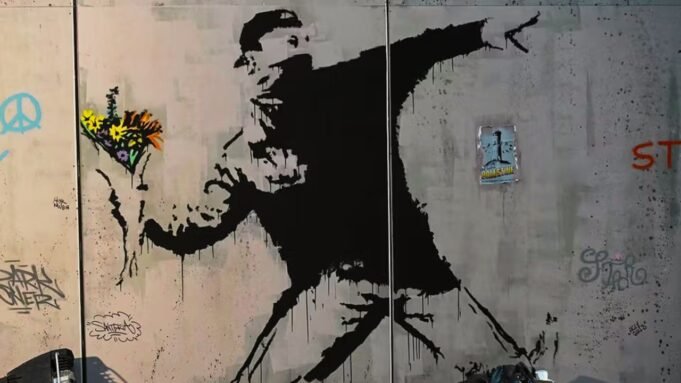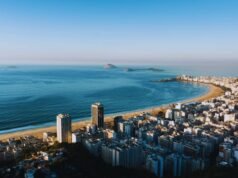Banksy Chicago the elusive street artist whose identity remains a mystery, has captivated the world with his provocative art that blends dark humor, political commentary, and social critique. Known for his distinct style, Banksy’s works have appeared in major cities across the globe, sparking conversations about the role of street art in society.
One of the cities where Banksy left his mark is Chicago, a vibrant hub of art and culture. His presence in the Windy City not only added to the city’s rich street art scene but also made a lasting impression on residents and tourists alike.
Who is Banksy?
Banksy Chicago’s true identity remains a mystery. Although some compelling evidence and photos are circulating online, the uncertainty adds to the allure of his work. The Art of Banksy exhibit features videos of people who know him and images of men believed to be him, but their faces are hidden.
The exhibit includes over 80 works that were commissioned by private collectors. While Banksy does not officially endorse the tour, all the pieces are authenticated by Pest Control, the organization Banksy established to manage his art.
Some of the most iconic pieces on display are Rude Copper, Girl with Balloon, and the altered Paris Hilton album cover.
I love discovering street art when exploring a city—whether it’s murals on buildings, sculptures, or unexpected installations. Some of my favorite street art from around the world is featured here.
History of Banksy’s Art in Chicago
Banksy’s first appearance in Chicago dates back to 2010 when several of his pieces mysteriously popped up around the city. As is typical of his guerrilla-style approach, the works appeared overnight, quickly drawing attention and sparking curiosity.
Chicago is known for its history of public art, from murals to sculptures, which became the perfect canvas for Banksy’s powerful, often political, expressions. These pieces were scattered in different parts of the city, creating a street art treasure hunt for locals eager to spot a genuine Banksy Chicago.
Related: Unforgettable Ways to Celebrate Special Occasions in Dubai
Famous Banksy Chicago Pieces
Several of Banksy’s works have gained prominence in Chicago. One of the most notable is the image of a rat holding a sign that says “Go Back to Bed, America,” found on the side of a building in the city’s West Loop neighborhood. This piece, like much of Banksy’s work, critiques societal complacency and conformity.
Another famous piece was a depiction of a young girl hugging a bomb, located in an industrial area. This artwork addressed themes of innocence, violence, and the militarization of society, resonating with a city like Chicago that grapples with its issues of violence.
Unfortunately, many of Banksy’s works in Chicago were defaced or painted over within weeks of their appearance, adding a layer of ephemerality to his message. This fragility only made his works more iconic, representing not just the fleeting nature of street art but also the transient, ever-changing dynamics of urban life.
Public Reaction to Banksy in Chicago
When Banksy Chicago works first appeared in Chicago, they garnered a range of reactions. Some residents and art enthusiasts were thrilled, seeing it as a sign that Chicago was recognized by one of the world’s most influential street artists. Others viewed his work more critically, questioning whether it belonged in public spaces without formal permission.
There were also controversies surrounding the preservation of Banksy’s works. In some instances, property owners were unsure whether to protect the art or remove it. Some works were vandalized shortly after they appeared, sparking debates about the ownership and longevity of street art. Nonetheless, Banksy’s presence in Chicago elevated conversations around street art’s legitimacy as an art form and its role in public discourse.
Banksy and Chicago’s Street Art Scene
Banksy’s influence on Chicago’s street art scene has been profound. Long known for its murals and public art, Chicago is home to a vibrant community of street artists. Banksy Chicago’s unexpected contributions to the city’s walls reinvigorated local interest in street art and encouraged new artists to use public spaces as platforms for political and social expression.
Many local street artists were inspired by Banksy’s work to incorporate more direct social and political themes into their creations. His presence pushed the boundaries of what was acceptable in public art, leading to a surge in street art installations that addressed Chicago-specific issues such as inequality, racial tensions, and urban development.
Read More: 6 Things You Should Know About Maslenitsa
Specter Sidebusts Banksy in Chicago
The “Specter Sidebusts Banksy” incident in Chicago refers to a moment when local street artist Specter painted over one of Banksy’s works in the city. Banksy’s original piece, known for its bold political and social commentary, was targeted by Specter as a statement on the commercialization of street art.
Specter’s action highlighted the tension between the authenticity of street art and the growing market around Banksy’s works, which often end up in galleries or auctions. This act of “sidebusting” added another layer of debate about ownership, public space, and the fleeting nature of urban art.
Banksy Chicago’s Message and Social Commentary
At the heart of Banksy’s work is a commitment to social commentary. His art often tackles themes such as capitalism, war, surveillance, and environmental destruction, all delivered with a unique blend of satire and seriousness. In Chicago, a city with a rich history of social movements and activism, Banksy’s messages found a receptive audience.
Banksy’s pieces in Chicago echoed many of the city’s struggles, such as economic inequality, police violence, and systemic injustice. Through his art, Banksy amplified the voices of the marginalized, turning everyday city walls into platforms for resistance and change. His works invited viewers to question the world around them and rethink their roles within societal structures.
Where to See Banksy’s Work in Chicago Today?
Though many of Banksy’s original works in Chicago have been lost to vandalism or removal, there are still a few pieces that can be viewed today. Some have been preserved by private owners who recognized their cultural and artistic value, while others have been hidden away in more obscure corners of the city. Art enthusiasts who wish to see Banksy’s work can embark on a self-guided tour to explore areas like the West Loop and Wicker Park, where some of his pieces originally appeared.
For those unable to find the original works, several exhibitions have been held in Chicago that feature reproductions of Banksy’s art or artwork inspired by his style. These exhibitions offer a glimpse into the mind of the artist and allow visitors to experience the impact of his work up close.
Read Also: Artistry in Event Planning
Is Banksy Museum Worth it?
Visiting a Banksy museum or exhibit can be a worthwhile experience for fans of street art and those curious about his thought-provoking works. The exhibit often features a large collection of his most famous pieces, offering a rare opportunity to see them up close, especially since many original murals are either removed or defaced over time.
While Banksy himself doesn’t authorize these exhibitions, the artwork is typically authenticated by Pest Control, the artist’s verification service. For anyone interested in street art, social commentary, and urban culture, a Banksy museum provides insight into his creative genius and the messages behind his art.
Conclusion
Banksy’s contributions to Chicago’s street art scene may have been brief, but they left a lasting mark. His works brought attention to the power of street art as a medium for social change and revitalized the city’s conversation around public art. As the mysterious artist continues to make headlines around the world, Chicago’s experience with Banksy stands as a reminder of the transformative potential of art in urban spaces. Whether seen on a city wall or in an exhibition, Banksy Chicago’s art continues to challenge, provoke, and inspire.
To Know More: The Ultimate Guide to Hosting a Great Party
Frequently Asked Questions (FAQs) About Banksy Chicago
We address the most frequently asked questions about Banksy’s presence in Chicago, exploring his art, impact, and the ongoing conversations surrounding street art in the Windy City.
Who is Banksy, and why is his work significant?
Banksy is an anonymous British street artist known for his politically charged and thought-provoking graffiti. His work often highlights social and political issues through satire and dark humor.
Where can I find Banksy’s art in Chicago?
Banksy’s art appeared in various Chicago locations, including the West Loop and Wicker Park. However, many of his original pieces have been removed, vandalized, or altered over time.
Is Banksy’s art still visible in Chicago?
While some pieces have been preserved by private owners, most of Banksy’s original street art in Chicago has been lost or painted over. You can still view his work through exhibitions or online galleries.
What is Banksy’s most famous piece in Chicago?
One of Banksy’s most notable Chicago works was the “rat holding a sign,” critiquing American complacency. This piece became iconic, but like much of his street art, it has since been removed.
Why is Banksy’s identity kept a secret?
Banksy’s identity remains hidden to avoid legal repercussions for his unauthorized public graffiti and to preserve the mystery that surrounds his persona, adding intrigue to his work.
Has Banksy authorized any exhibits in Chicago?
No, Banksy has not authorized any exhibits or tours of his work. However, exhibitions showcasing his art have featured authenticated pieces verified by Pest Control, the agency that handles Banksy’s artwork.
How has Banksy influenced Chicago’s street art scene?
Banksy’s presence in Chicago has inspired local street artists to explore deeper political and social themes in their work, contributing to the city’s already rich street art culture.















